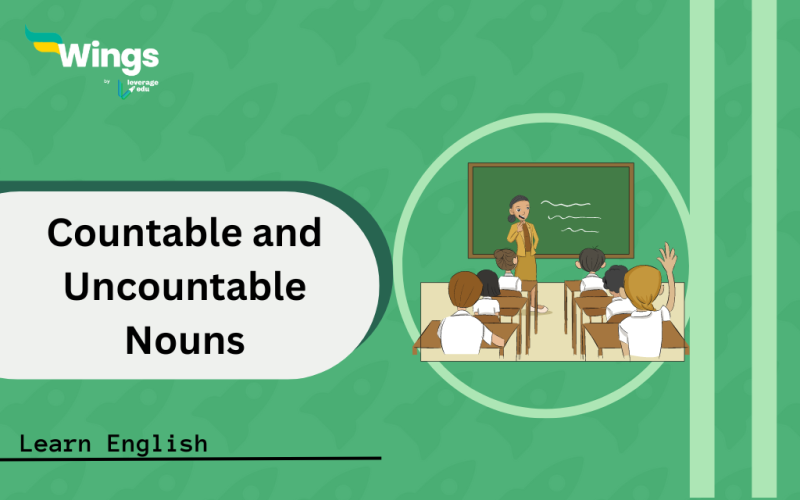Have you ever wondered why is it “the flour” and “a dough’, and not “a flour” and “the dough”? If yes, then you are probably dealing with countable and uncountable nouns. They may sound as easy as the singular and plural nouns, but they can also get tricky at times if you are struggling with the rules of nouns in English grammar. Therefore, let’s hop on and find out through this blog, why we needed the aid of countable and uncountable nouns to make ourselves as proficient as a grammar nazi.
This Blog Includes:
Must Read: Nouns: Examples, Definition, Types
What are Countable and Uncountable Nouns?
In layman’s language, if a noun, specifically animals, places, things, individuals, ideas, and more can be counted numerically, you can categorise them as countable nouns. On the other hand, if you can measure an object quantitatively, but cannot count it, you are dealing with an uncountable noun.
That is why, ‘the flour’, in the introduction was represented with ‘the’ and once kneaded, it became ‘a dough’ with the English grammar article ‘a’, giving back your superpower of counting. Take a look at another example below before studying both the nouns separately.
- There is a dog in the yard [Countable]
- I need some water to drink. [Uncountable]
Countable Noun Examples
By now, you are aware that any person, place or thing that you can count is called a countable noun. But, did you know that countable nouns are further studied in the form of singular nouns and plural nouns? To elaborate, you can easily assign numbers like a, one, two, three, etc. That is how they represent things we can readily quantify, from tiny pebbles on the beach to towering skyscrapers in a bustling city.
Example:
- There is a cat in the backyard. [Singular Noun]
- There are three cats in the backyard [Plural Noun]
Uncountable Noun Examples
Uncountable nouns, unlike their countable brethren, are the elusive chameleons of language. On a simpler note, imagine the vast expense of the ocean, the boundless sky, or the shimmering sands of the desert. These are uncountable nouns, entities that exist in a continuous, immeasurable whole. It represents abstract concepts or material that exist in a unified state.
Here are some common examples that fall under the category of uncountables:
| Abstract concepts | time, money, love, intelligence, joy |
| Materials | air, water, sand, wood, steel |
| Liquids and gases | milk, coffee, gasoline, oxygen |
| Mass nouns | furniture, rice, information, laughter |
Must Read: Noun, verb, adjective, and adverb
How to Use Countable and Uncountable Nouns?
Let’s quickly go through a few rules you cannot undermine while using countable and uncountable nouns:
Use of Article
| Countable Noun | Uncountable Noun |
| You can use both definite (the) and indefinite (a/an) articles | It often comes with the definite (the) article or without any article |
| Example: “I have a book.” or “The book is on the shelf.” | Example: “I need the information.” or “She has water.” |
Use of Quantifiers
| Countable Noun | Uncountable Noun |
| It can be modified by numbers or words like “many,” “few,” “several,” etc. | They are often modified by words like “much,” “little,” “some,” etc. |
| Example: “Many students attended the seminar.” | Example: “She has little patience.” |
Countable and Uncountable Nouns Exercises for Practise
Now that everything is said and done, make sure to check your knowledge:
Exercise 1 – Identify the Noun
Q. Read each sentence carefully and identify the nouns in each sentence. Choose the correct option for the underlined word’s role as a noun.
- The resilience of the community was evident in the face of adversity.
- The scientist conducted experiments to study the behaviour of neutrinos.
- The team explored the mysterious cave, discovering ancient relics.
- In the Andes, hikers experience the breathtaking beauty of nature.
- The cacophony of city life can be overwhelming at times.
- The committee made decisions regarding the allocation of resources.
- During the storm, we sought refuge in the historic building.
- The orchestra’s performance evoked powerful emotions through its musical compositions.
- In the distance, a herd of elephants gracefully moved through the savannah.
- The poet captured the essence of love in his poignant verses.
Answers
- Abstract Noun
- Common Noun
- Common Noun
- Proper Noun
- Abstract Noun
- Common Noun
- Proper Noun
- Common Noun
- Collective Noun
- Common Noun
Exercise 2 – Fill in the blanks with Quantifiers
Q. Choose the appropriate quantifier [e.g., many, much, a few, a little, etc.] to fill in the blanks in each sentence:
- There are ___________ books on the shelf.
- Can you pass me ___________ sugar for my coffee?
- She has ___________ friends in the new city.
- There is ___________ milk in the refrigerator.
- I have ___________ time to finish the assignment.
Answers
- many
- some
- a few
- some
- little
Find More Informative Reads in English below
This was all about countable and countable nouns and exercises. Hope you understand the concept and know how to proceed. You can also follow Leverage Edu for more exciting and informative blogs.
 One app for all your study abroad needs
One app for all your study abroad needs














 45,000+ students realised their study abroad dream with us. Take the first step today.
45,000+ students realised their study abroad dream with us. Take the first step today.

